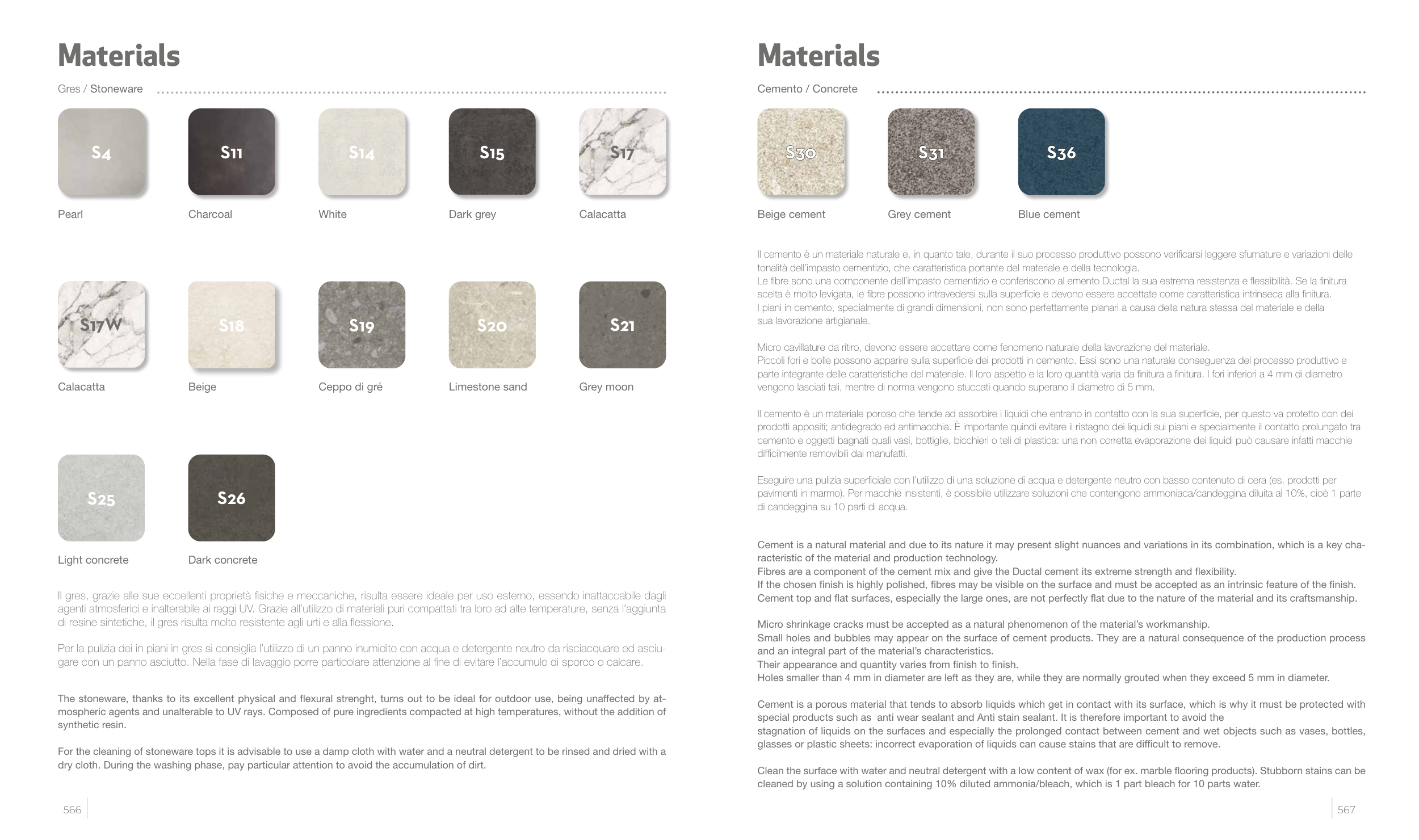Materials
Materials
Il cemento è un materiale naturale e, in quanto tale, durante il suo processo produttivo possono verificarsi leggere sfumature e variazioni delle
tonalità dell’impasto cementizio, che caratteristica portante del materiale e della tecnologia.
Le fibre sono una componente dell’impasto cementizio e conferiscono al emento Ductal la sua estrema resistenza e flessibilità. Se la finitura
scelta è molto levigata, le fibre possono intravedersi sulla superficie e devono essere accettate come caratteristica intrinseca alla finitura.
I piani in cemento, specialmente di grandi dimensioni, non sono perfettamente planari a causa della natura stessa del materiale e della
sua lavorazione artigianale.
Micro cavillature da ritiro, devono essere accettare come fenomeno naturale della lavorazione del materiale.
Piccoli fori e bolle possono apparire sulla superficie dei prodotti in cemento. Essi sono una naturale conseguenza del processo produttivo e
parte integrante delle caratteristiche del materiale. Il loro aspetto e la loro quantità varia da finitura a finitura. I fori inferiori a 4 mm di diametro
vengono lasciati tali, mentre di norma vengono stuccati quando superano il diametro di 5 mm.
Il cemento è un materiale poroso che tende ad assorbire i liquidi che entrano in contatto con la sua superficie, per questo va protetto con dei
prodotti appositi; antidegrado ed antimacchia. È importante quindi evitare il ristagno dei liquidi sui piani e specialmente il contatto prolungato tra
cemento e oggetti bagnati quali vasi, bottiglie, bicchieri o teli di plastica: una non corretta evaporazione dei liquidi può causare infatti macchie
difficilmente removibili dai manufatti.
Eseguire una pulizia superficiale con l’utilizzo di una soluzione di acqua e detergente neutro con basso contenuto di cera (es. prodotti per
pavimenti in marmo). Per macchie insistenti, è possibile utilizzare soluzioni che contengono ammoniaca/candeggina diluita al 10%, cioè 1 parte
di candeggina su 10 parti di acqua.
Cement is a natural material and due to its nature it may present slight nuances and variations in its combination, which is a key cha-
racteristic of the material and production technology.
Fibres are a component of the cement mix and give the Ductal cement its extreme strength and flexibility.
If the chosen finish is highly polished, fibres may be visible on the surface and must be accepted as an intrinsic feature of the finish.
Cement top and flat surfaces, especially the large ones, are not perfectly flat due to the nature of the material and its craftsmanship.
Micro shrinkage cracks must be accepted as a natural phenomenon of the material’s workmanship.
Small holes and bubbles may appear on the surface of cement products. They are a natural consequence of the production process
and an integral part of the material’s characteristics.
Their appearance and quantity varies from finish to finish.
Holes smaller than 4 mm in diameter are left as they are, while they are normally grouted when they exceed 5 mm in diameter.
Cement is a porous material that tends to absorb liquids which get in contact with its surface, which is why it must be protected with
special products such as anti wear sealant and Anti stain sealant. It is therefore important to avoid the
stagnation of liquids on the surfaces and especially the prolonged contact between cement and wet objects such as vases, bottles,
glasses or plastic sheets: incorrect evaporation of liquids can cause stains that are difficult to remove.
Clean the surface with water and neutral detergent with a low content of wax (for ex. marble flooring products). Stubborn stains can be
cleaned by using a solution containing 10% diluted ammonia/bleach, which is 1 part bleach for 10 parts water.
Cemento / Concrete
Beige cement
Grey cement
Blue cement
S30
S30
S31
S31
S36
S36
Pearl
Beige
Ceppo di gré
Limestone sand
Light concrete
Grey moon
Dark concrete
Charcoal
White
Dark grey
Calacatta
Calacatta
Gres / Stoneware
S14
S15
S17
S17W
Il gres, grazie alle sue eccellenti proprietà fisiche e meccaniche, risulta essere ideale per uso esterno, essendo inattaccabile dagli
agenti atmosferici e inalterabile ai raggi UV. Grazie all’utilizzo di materiali puri compattati tra loro ad alte temperature, senza l’aggiunta
di resine sintetiche, il gres risulta molto resistente agli urti e alla flessione.
Per la pulizia dei in piani in gres si consiglia l’utilizzo di un panno inumidito con acqua e detergente neutro da risciacquare ed asciu-
gare con un panno asciutto. Nella fase di lavaggio porre particolare attenzione al fine di evitare l’accumulo di sporco o calcare.
The stoneware, thanks to its excellent physical and flexural strenght, turns out to be ideal for outdoor use, being unaffected by at-
mospheric agents and unalterable to UV rays. Composed of pure ingredients compacted at high temperatures, without the addition of
synthetic resin.
For the cleaning of stoneware tops it is advisable to use a damp cloth with water and a neutral detergent to be rinsed and dried with a
dry cloth. During the washing phase, pay particular attention to avoid the accumulation of dirt.
S11
S4
S18
S19
S20
S25
S21
S26
567
566







